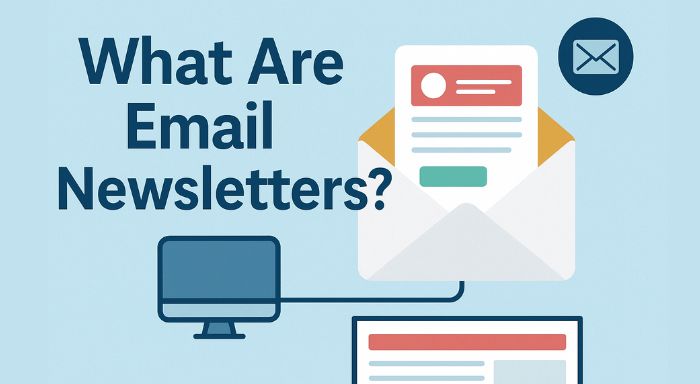Email newsletters have become one of the most effective tools for businesses and individuals to connect with their audience. From sharing updates to promoting products and services, newsletters remain a vital communication channel in digital marketing. Companies like Extract Mails emphasize the importance of email communication in building strong, long-term customer relationships.
In this guide, we’ll explore what email newsletters are, why they matter, the different types, and how you can create impactful ones that drive results.
Understanding Email Newsletters
An email newsletter is a type of digital communication sent to subscribers who voluntarily sign up to receive updates from a brand, company, or individual. These newsletters usually contain valuable information such as:
- Company news and updates
- Special offers and promotions
- Blog posts or curated content
- Event announcements
- Industry insights
The goal of an email newsletter is not just to inform but also to engage and nurture the audience over time. Unlike promotional emails that focus solely on sales, newsletters often provide educational or entertaining content that adds real value to the reader.
Why Are Email Newsletters Important?
Email newsletters continue to be one of the most effective marketing tools despite the rise of social media and messaging apps. Here’s why they matter:
- Direct Communication: Unlike social media, where algorithms decide who sees your content, newsletters go straight to a subscriber’s inbox.
- Stronger Relationships: By providing consistent value, you build trust with your readers.
- Higher ROI: Email marketing typically delivers a higher return on investment compared to other channels.
- Customization: Emails can be segmented and personalized based on customer behavior and preferences.
- Data Insights: Businesses can track open rates, clicks, and conversions to optimize future campaigns.
Key Components of an Effective Email Newsletter
To make newsletters impactful, they must be designed with certain key elements in mind:
- Subject Line: Grabs attention and encourages recipients to open the email.
- Header and Branding: Reinforces your identity and keeps the design professional.
- Body Content: Provides valuable and relevant information.
- Visuals: Images, infographics, or videos make newsletters more engaging.
- Call-to-Action (CTA): Encourages readers to take action, like visiting a website or making a purchase.
- Footer: Includes important details like contact information and unsubscribe options.
Types of Email Newsletters
Different businesses use newsletters in different ways. Here are the most common types:
| Type of Newsletter | Purpose | Example |
| Company Updates | Share company news, events, or milestones | Launch announcements |
| Promotional Emails | Highlight sales, discounts, or new arrivals | Holiday offers |
| Educational Content | Provide valuable tips, guides, or insights | Marketing strategies |
| Curated Content | Share articles, blogs, or external resources | Weekly industry roundups |
| Event Invitations | Invite subscribers to webinars, workshops, or meetups | Live product demos |
| Customer Stories | Showcase testimonials or case studies | Client success stories |
By choosing the right type of newsletter, you can align your communication strategy with your business goals.
How to Create a Successful Email Newsletter
Creating a newsletter requires more than just writing content and sending it out. Here’s a step-by-step process to get it right:
1. Define Your Goal
Decide what you want to achieve—whether it’s boosting sales, increasing website traffic, or educating your audience.
2. Build Your Subscriber List
Only send newsletters to people who opt in. You can collect subscribers through signup forms, landing pages, or incentives like free ebooks.
3. Choose the Right Tools
There are several platforms like Mailchimp, Constant Contact, and ConvertKit that make it easy to design, send, and track newsletters.
4. Segment Your Audience
Not all subscribers are the same. Segmenting helps you send targeted messages, which increases engagement and conversions.
5. Create Engaging Content
Mix promotional content with value-driven insights. Too much promotion can lead to unsubscribes.
6. Optimize for Mobile
Since many people open emails on their phones, ensure your newsletter design is mobile-friendly.
7. Test and Improve
Run A/B tests on subject lines, CTAs, or layouts to see what works best.
Challenges of Email Newsletters
While newsletters are powerful, they also come with challenges:
- Deliverability Issues: Emails may land in spam folders.
- Low Open Rates: Without strong subject lines, people may ignore emails.
- Unsubscribes: Poor content or excessive frequency can cause readers to leave.
- Time-Consuming: Consistently creating high-quality content requires effort.
To overcome these, businesses often use automation and supporting tools such as an email extraction tool to manage subscriber data efficiently and keep their campaigns running smoothly.
Best Practices for Email Newsletters
Here are some tips to make sure your newsletters stand out:
- Keep your content concise and easy to read.
- Use personalized greetings to connect with readers.
- Maintain a consistent sending schedule (weekly, bi-weekly, or monthly).
- Make subject lines clear and enticing.
- Use visuals but don’t overload emails with heavy images.
- Always include an easy unsubscribe option.
- Track analytics to measure performance and refine your strategy.
Benefits of Using Email Newsletters
Let’s look at the main advantages newsletters bring to businesses:
- Cost-Effective Marketing: Compared to traditional ads, newsletters are budget-friendly.
- Improved Customer Retention: Regular updates keep your brand top-of-mind.
- Lead Nurturing: Newsletters help guide potential customers through the sales funnel.
- Increased Website Traffic: Including blog links and CTAs drives users to your site.
- Brand Awareness: Consistent communication strengthens brand recognition.
Future of Email Newsletters
With AI and automation, email newsletters are becoming more personalized than ever. Predictive analytics helps businesses send the right message at the right time, while interactive elements like polls or quizzes increase engagement. As privacy regulations evolve, businesses will also need to ensure transparency and compliance while maintaining subscriber trust.
Conclusion
Email newsletters are a timeless yet evolving tool for businesses to connect, educate, and engage their audience. Whether you’re running a small blog or managing a large enterprise, newsletters can help you build stronger relationships, drive conversions, and establish authority in your niche. By focusing on valuable content, personalization, and consistent communication, you can turn newsletters into one of your most powerful marketing assets.
And if you want to experiment with disposable email addresses for testing how your newsletters appear in different inboxes, tools like YOPmail can be incredibly handy.


Leave a Reply